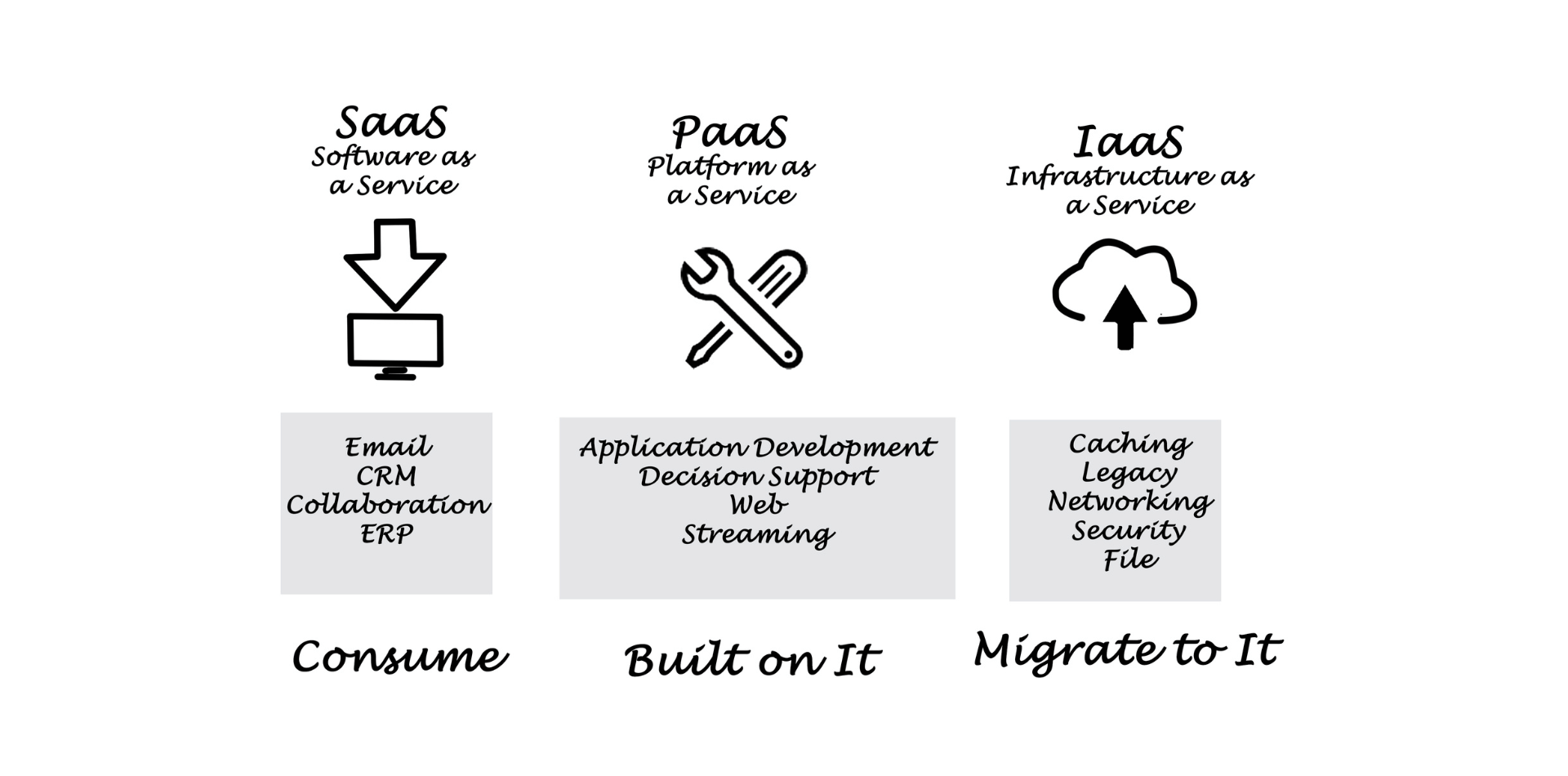What are the types of Cloud Services
The three main types of Cloud Services - Explained.

Cloud services offer a mix of services including Infrastructure as a Service (IaaS), Platform as a Service (PaaS), and packaged Software as a Service (SaaS) offerings.
Cloud services are designed to provide organisations with tools such as compute power, database storage, and content delivery services, among many others, to help them scale and grow.
Infrastructure as a Service (IaaS)
Infrastructure as a Service (IaaS) is a form of cloud computing that provides virtualised computing resources over the internet.
In an IaaS model, a cloud provider hosts the infrastructure components traditionally present in an on-premises data centre, including servers, storage, and networking hardware, as well as the virtualisation or hypervisor layer.
Key characteristics and components of IaaS include:
Virtualisation:
IaaS relies heavily on virtualisation technology.
It abstracts the physical hardware and provides resources as virtual instances to users. This virtualisation allows for more efficient utilisation of physical resources and easier scalability.
Scalability and Elasticity:
One of the main benefits of IaaS is its scalability.
Resources can be scaled up or down quickly based on demand, which is ideal for businesses with fluctuating needs.
Self-Service and On-Demand:
IaaS allows users to provision resources on-demand through a web-based interface or API.
Users can create, configure, and manage their own virtual machines, storage, and networking as needed, without having to physically set up hardware.
Pay-as-you-go Pricing:
Typically, IaaS services are offered on a pay-as-you-go basis.
Users pay only for the resources they consume, which can lead to cost savings compared to managing physical infrastructure.
Resource Pooling and Multi-Tenancy:
In IaaS, resources are pooled to serve multiple customers using a multi-tenant model.
Different physical and virtual resources are dynamically assigned and reassigned according to customer demand.
Network Access:
IaaS provides broad network access, allowing users to access the resources from anywhere over the internet.
Maintenance and Management:
The IaaS provider is responsible for maintaining and managing the underlying infrastructure, including hardware, software, networking, and storage.
This reduces the burden on users to manage and maintain physical hardware.
Examples of IaaS include:
- Amazon EC2 (Elastic Compute Cloud)
- Google Compute Engine (GCE)
- Microsoft Azure Virtual Machines.
These services offer users the flexibility to run their applications and workloads on virtual machines, with the cloud provider managing and maintaining the underlying physical infrastructure.
IaaS is widely used by businesses of all sizes for various purposes, such as website hosting, data storage, backup and recovery, web apps, high-performance computing, and big data analysis.
It's particularly beneficial for businesses looking to avoid the complexity and cost of buying and managing their own physical servers and other data centre infrastructure.

Platform as a Service (PaaS)
Platform as a Service (PaaS) is a cloud computing model that provides customers with a platform, including hardware and software tools, typically for application development and hosting.
In the PaaS model, a cloud provider delivers infrastructure and software frameworks, but users can develop and run their applications.
This service is hosted in the cloud and accessed by users over the internet.
Key characteristics and components of PaaS include:
Development Frameworks and Tools:
PaaS provides a framework that developers can use to build, test, deploy, and manage applications.
This framework can include development tools, programming languages, libraries, and application programming interfaces (APIs).
Middleware Services:
PaaS often includes middleware services, which are software components that sit between the operating system and the applications.
These services can include database management, messaging queues, and caching services.
Runtime Environment:
PaaS provides a runtime environment for applications.
Once an application is developed, it can be deployed and hosted on the PaaS platform.
Scalability and Elasticity:
Similar to IaaS, PaaS allows for scalability. Resources can be automatically scaled up or down based on the application's needs.
Integrated Development Environment (IDE):
Many PaaS providers offer an integrated development environment.
This can be a web-based interface where developers can write, test, and deploy their code directly in the cloud.
Collaboration:
PaaS platforms are often equipped with collaboration tools that enable multiple developers to work on the same application simultaneously.
Managed Services:
The PaaS provider manages the underlying infrastructure, operating systems, and middleware, allowing developers to focus on the application development without worrying about environment setup, capacity planning, software maintenance, patching, or any of the other undifferentiated heavy lifting involved in running an application.
Cost-Effectiveness:
Since PaaS includes infrastructure, businesses can save on the cost of purchasing and managing their own hardware and software layers.
Examples of PaaS include Google App Engine, Microsoft Azure App Services, and Heroku.
These platforms provide a managed environment where developers can create, deploy, and manage web applications without the complexity of building and maintaining the infrastructure typically associated with developing and launching an app.
PaaS is particularly beneficial for developers who want to automate the deployment of applications or for organizations that want to streamline workflows when multiple developers are working on the same development project. It is also useful for businesses that want to rapidly develop and deploy applications without the overhead of setting up and maintaining the underlying infrastructure and software development tools.

Software as a Service (SaaS)
Software as a Service (SaaS) is a cloud computing model in which software applications are delivered over the internet as a service, rather than being installed and maintained on individual user computers.
In the SaaS model, users access software applications via a web browser or a lightweight client application, and the software is hosted and maintained by the service provider.
Key characteristics and components of SaaS include:
Web-based Access:
SaaS applications are typically accessed through a web browser, which means users can access the software from any internet-enabled device. This eliminates the need for local installation and makes the application universally accessible.
Subscription Model:
SaaS is often offered on a subscription basis, where users pay a recurring fee to access the software.
This fee can be based on various factors, such as the number of users, the level of service, or the amount of data used.
Centralised Hosting and Management:
The software application is hosted on the service provider's infrastructure, and the provider is responsible for maintaining the software, including updates, security patches, and ensuring that the service is available and performing well.
Scalability and Flexibility:
SaaS solutions are inherently scalable, allowing users to easily add or remove users, increase storage, or upgrade features as needed. This flexibility supports changing business needs without significant investment in hardware or software.
Automatic Updates:
The SaaS provider manages updates and upgrades, ensuring that all users have access to the latest features and security updates without any effort on their part.
Multi-Tenancy:
In a SaaS environment, a single instance of the software may serve multiple customers.
Each customer's data and configurations are kept separate, but the underlying infrastructure and software are shared.
Data Security and Compliance:
SaaS providers typically offer robust security measures, including data encryption, secure data centers, and compliance with various regulations and standards, to protect user data.
Collaboration and Integration:
Many SaaS applications offer collaboration features that enable users to work together in real-time.
Additionally, SaaS solutions often integrate with other software and services, providing a cohesive and interconnected set of tools.
Examples of SaaS include Google Workspace (formerly G Suite), Microsoft Office 365, Salesforce, Dropbox, Slack, and Zoom. These applications cover a wide range of functionalities, from email and collaboration to customer relationship management (CRM) and project management.
SaaS is popular among businesses of all sizes due to its ease of use, reduced cost of ownership, and flexibility. It allows businesses to quickly deploy and use applications without the need for extensive IT infrastructure and support.
This model is particularly beneficial for small and medium-sized businesses that may not have the resources to invest in and maintain on-premises software solutions.



